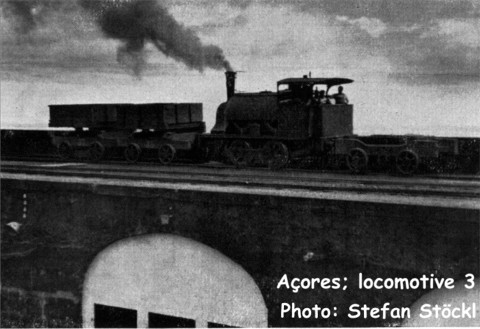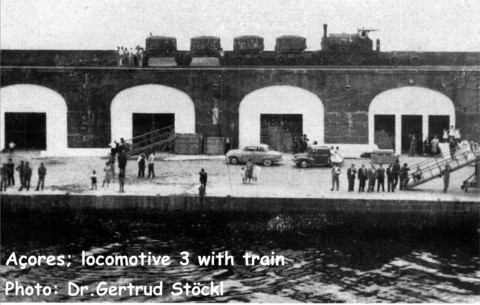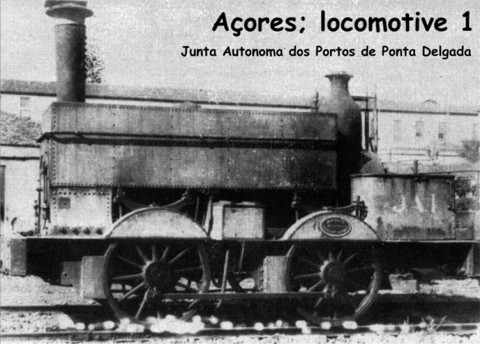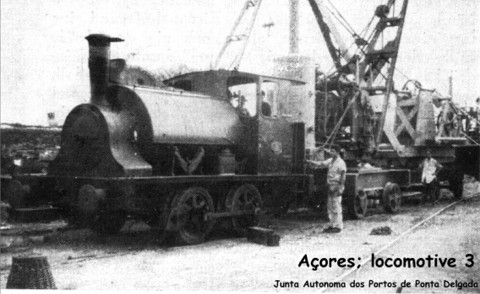Linha do Porto de bitola larga
Por volta de 1961 o Dr. Fritz Stöckl fez uma viagem (com a sua esposa e filho) com um navio a vapor da "Empresa Insulana de Navegação" que ligou numa viagem circular de 17 dias todos os Açores e a Madeira. Em Ponta Delgada descobriram carris e vagões no molhe. Após desembarcarem, Stöckl mediu ele próprio a bitola: 7 pés / 2134 mm! A bitola que tinha sido preferida por Brunel no século XIX em Inglaterra e durante várias décadas foi competetiva com a de 1435 mm até esta ficar a ser a bitola padrão.Stöckl e a sua família fizeram uma visita à ilha e tiveram de embarcar de novo, dado que o navio ia partir para a ilha seguinte. Quando o navio deixou o cais, de repente apareceu uma locomotiva a vapor no molhe.
Mais tarde, Stöckl contactou as autoridades do porto de Ponta Delgada, os proprietários da linha de caminho de ferro: "Junta Autónoma dos Portos do Ponta Delgada". Estes confirmaram a bitola e forneceram mais informações.
A linha foi construída ao mesmo tempo que o molhe em 1861. Não servia de transporte público mas era apenas usada para a construção e manutenção do molhe. Para tal, havia 3 locomotivas a vapor e 39 vagões para trazer pedras de uma pedreira próxima até ao porto. A locomotiva a vapor no.1, construída em 1861 por Neilson & Co. (no. 697), foi a última das três que tinha vindo em segunda mão para os Açores e tinha sido antes usada para o mesmo fim em Holyhead. A No.2 foi construída por Black Hawthorn (no.766) algures entre 1880 e 1888 e a no.3 por Falcon (no.165) em 1888.
Fotografias e fonte de informação: Dr. Fritz Stöckl - Die Eisenbahnen der Erde, Band III, Spanien und Portugal - publicado na Áustria em 1962.
A linha só funcionava se necessário, para a manutenção do molhe. A última vez de que há registos foi em 1973. As locomotivas (pelo menos duas) estão ainda (Junho de 2002) armazenadas nas oficinas da "Junta Autónoma dos Portos do Ponta Delgada". Plinthed é um vagão para mistura de cimento. Ver página de Chris Brady: The Broad Gauge Railway of the Azores.
Autor: Ernst Kers. Tradução: Luís Almeida




Broad gauge harbor line
Around 1961 an Austrian gentleman named Dr. Fritz Stöckl made a trip with his wife and son with a steam ship of the "Empresa Insulana de Navegação" which connected in a 17-days roundtrip all the Açores and Madeira. At Ponta Delgada they discovered rails and wagons on the jetty. After disembarking Stöckl did measure the gauge himself: 7 foot / 2134 mm! The gauge which was favoured by Brunel in the 19th century in England and for several decades competetive with 1435 mm to become standard gauge.Stöckl and his family made a sight seeing trip on the island and had to embark again as the ship was leaving for the next island. When the ship left the quay, suddenly a steam locomotive appeared on the jetty.
Later Stöckl contacted the authorities of the port of Ponta Delgada, the owners of the railway: "Junta Autonoma dos Portos do Ponta Delgada". They confirmed the gauge and provided more information.
The line was constructed together with the jetty in 1861. It did not serve the public transport but only was used for the construction and maintenance of the jetty. For this there were 3 steam locomotives and 39 wagons to bring stone from a nearby quarry to the harbour. Steamlocomotive no.1, constructed in 1861 by Neilson & Co. (no. 697; thanks to Mark Smithers for the research), was the last left of three which had become second hand to the Açores and were used before for the same purpose at Holyhead. No.2 was constructed by Black Hawthorn (no.766) somewhere between 1880 and 1888 and no.3 by Falcon (no.165) in 1888.
Photos and source of data: Dr. Fritz Stöckl - Die Eisenbahnen der Erde, Band III, Spanien und Portugal - published in Austria in 1962.
The line was worked only if required because of maintenance of the jetty. The last time reported in 1973. The locomotives (at least two) are still (June 2002) stabled in the workshops of the "Junta Autonoma dos Portos do Ponta Delgada". Plinthed is a cement mixing truck. See the page of Chris Brady: The Broad Gauge Railway of the Azores.
This page is written by Ernst Kers.